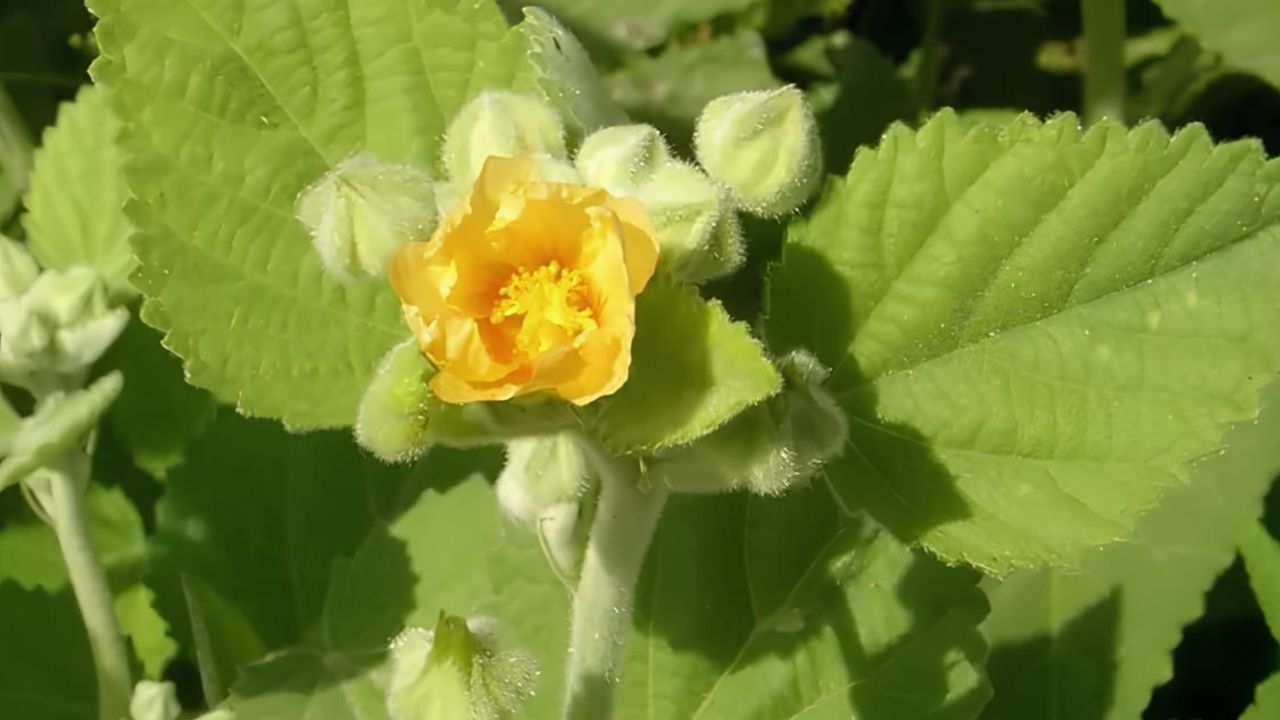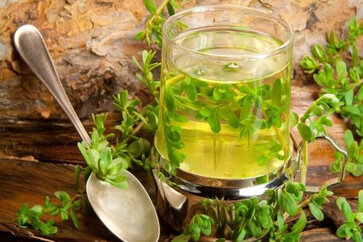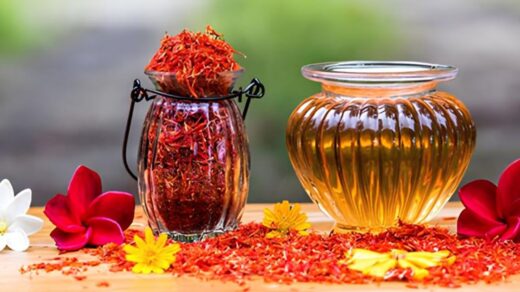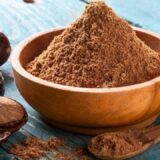Bala (Sida Cordifolia): Health Benefits, Uses, Dosage, and Side Effects
Bala, scientifically known as Sida cordifolia, is a significant herb in the Ayurvedic tradition, revered for its numerous health benefits. The name “Bala” translates to “strength” in English, reflecting its traditional use to enhance physical vitality, support bone and muscle health, and improve overall stamina.
This perennial herb can grow up to 30 meters tall and is characterized by its heart-shaped leaves and small, solitary white flowers. The robust roots and stems of Bala are integral to its strength and effectiveness. Native to India, Bala commonly flourishes in wastelands and along roadsides, and it is found throughout tropical and subtropical regions of India and Sri Lanka.
It has a longstanding history of use in traditional medicine, where various parts of the plant are utilized to create formulations that address a range of health issues. Beyond its medicinal properties, Bala is also associated with beauty and grace, linked to the Hindu goddess Parvati.
Bala (Sida Cordifolia) in Ayurveda
Bala (Sida cordifolia) has a rich history within Ayurvedic literature, where it is frequently mentioned for its numerous health benefits. Ancient texts like the Charaka Samhita and the Sushruta Samhita highlight its use in promoting strength, enhancing vitality, and treating various ailments.
Traditionally, Bala has been recognized not only for its physical benefits but also for its role in supporting overall wellness and beauty, often linked to the goddess Parvati, symbolizing grace and femininity.
Bala (Sida Cordifolia) Botanical Description
- Growth Habit: Bala is a robust perennial herb, typically reaching heights of 1 to 2 meters, although some varieties may grow taller under optimal conditions.
- Leaves: The leaves are heart-shaped (cordate) or oblong, generally green in color. They are alternate, with a smooth margin and a slightly serrated edge. Leaf size can vary, typically measuring between 5 to 10 cm in length.
- Flowers: The plant produces small, solitary white flowers that bloom in axillary positions. Each flower has five petals and is around 1 to 2 cm in diameter. They can attract various pollinators, contributing to the plant’s reproductive success.
- Stems and Roots: Bala has stout, robust stems that provide structural support. The roots are also strong, allowing the plant to thrive in a variety of soil types and contributing to its resilience in different environments.
- Habitat: It typically grows in open, disturbed areas such as roadsides, fields, and wastelands, and is often found in well-drained soils.
- Ecological Importance: Besides its aesthetic value, Bala plays a role in local ecosystems by providing habitat for various insects and contributing to soil stabilization.
This combination of features makes Bala a distinctive and resilient herb in its natural habitat.
Distribution and Habitat of Bala (Sida cordifolia)
Bala (Sida cordifolia) is predominantly native to India, with a significant presence in Sri Lanka and other tropical and subtropical regions. Its distribution reflects its adaptability to a variety of environments. Here are some key aspects of its distribution and habitat:
Geographical Range: Bala is found throughout most of India, especially in states with warm climates. It also extends to parts of Southeast Asia and Africa, where similar climatic conditions prevail.
Habitat:
- Wastelands: Bala thrives in disturbed, open areas, including wastelands where other vegetation may struggle to establish.
- Roadsides: It often grows along roadsides, taking advantage of the sunlight and space.
- Open Fields: The plant is commonly seen in agricultural fields and grasslands, where it can compete effectively for resources.
Vernacular Names of Bala (Sida cordifolia)
Bala Names
- Latin Name: Sida cordifolia
- Common Names: Country mallow, Heart-leaf sida
- Sanskrit Names: Badiyalaka, Bala, Baladaya
- Bengali Name: Berela
- Assamese Name: Bor sonborial
- Hindi Names: Kharinta, Barial
- Kannada Names: Chittuharalu, Hettuti-gida
- Malayalam Name: Katturam
- Tamil Name: Chittamuttie
- Telugu Names: Chirubenda, Mailmanikkam
- Marathi Names: Bala, Chikana, Tupkaria
- Odia Names: Bajromuli, Bisiripi
- Gujarati Name: Jangli methi
- Chinese Names: Yuan ye jin wu shi hua, Ke dong, Xin ye huang hua ren
- French Name: Herbe de douze heyres
- Japanese Name: Maruba kingojika
- Nepalese Name: Balu
- Russian Names: Sida Kordifolia, Sida Serdtselistania
- Spanish Names: Escoba Negra, Escobilla, Llima
- Thai Name: Ya khat bai pom
Ayurvedic Properties of Bala (Sida cordifolia)
In Ayurveda, Bala is primarily known for its ability to balance the Vata and Pitta doshas. It is considered beneficial for individuals with Vata imbalances, as it helps to ground and strengthen the body.
Bala’s nourishing qualities also support Pitta, promoting healthy digestion and metabolic processes. Its soothing properties make it a valuable herb for maintaining overall harmony in the body, helping to alleviate symptoms associated with imbalances in these doshas.
Rasa, Virya, and Vipaka of Bala
In Ayurvedic terminology, the properties of a herb are described through Rasa (taste), Virya (potency), and Vipaka (post-digestive effect):
- Rasa: Bala has a sweet and slightly bitter taste, which contributes to its nourishing and restorative qualities. The sweetness is especially beneficial for balancing Vata.
- Virya: The potency of Bala is considered to be warm. This warming quality enhances circulation and helps in the strengthening of tissues and muscles, making it ideal for those seeking to build stamina and vitality.
- Vipaka: The post-digestive effect of Bala is sweet, which means it supports nourishment and vitality in the body after digestion. This quality aids in promoting overall health and wellness.
Together, these properties make Bala a versatile herb in Ayurvedic practice, valued for its ability to enhance strength and support overall health.
Varieties of Bala (Sida cordifolia)
The different varieties of Bala as mentioned in Ayurvedic texts:
- Batyalaka (Sida cordifolia): The primary variety known for its rejuvenative properties.
- Mahabala (Sida rhomboidea): Valued for its strength-enhancing effects and medicinal benefits.
- Atibala (Sida rhombifolia): Recognized for its potential in treating various ailments, particularly in traditional medicine.
- Nagabala (Sida alba): Often used for its healing properties and benefits in specific health conditions.
These varieties highlight the diverse applications and significance of the Bala genus in Ayurvedic practices.
Ayurvedic Medicinal Properties of Bala (Sida cordifolia)
- Tridoshahara: Balances Vata, Pitta, and Kapha dosha.
- Rasayana: Rejuvenative properties that promote overall vitality.
- Vrushya: Acts as an aphrodisiac, enhancing sexual health.
- Samgrahi: Absorbent, useful in various digestive issues.
- Rakthapitta Samaka: Alleviates bleeding disorders.
- Mutrala: Increases the production of urine, supporting urinary health.
- Jvaraghna: Relieves fever, helping to reduce body temperature.
- Balya: Improves strength and overall vitality.
- Hrudya: Beneficial for heart health.
These properties highlight Bala’s significance in traditional medicine, particularly within Ayurvedic practices.
Parts Used of Bala (Sida cordifolia)
- Bala Roots: Used for their rejuvenative and strengthening properties.
- Bala Bark: Often utilized for its supportive effects on various health conditions.
- Bala Leaves: Commonly used in preparations for their nutritional and medicinal benefits.
- Bala Flowers: Used in herbal remedies for their therapeutic properties.
- Bala Seeds: Employed for various medicinal applications and sometimes in traditional preparations.
Ayurvedic Uses of Bala (Sida cordifolia)
1. Anti-inflammatory: Reduces inflammation in wounds and eyes; external application alleviates arthritis pain and joint stiffness; used in paste form for ophthalmic diseases and wound healing.
2. Cervical and Facial Paralysis: Oil prepared from Bala is effective for cervical spondylitis, paralysis, and facial paralysis.
3. Digestive Health: Aids in the absorption of water and nutrients; controls intestinal motility, beneficial for irritable bowel syndrome (grahani).
4. Cardiac Health: Reduces petechial hemorrhage and acts as a cardiac tonic.
5. Fertility: Treats male and female infertility; increases sperm count and motility in males; used for erectile dysfunction and premature ejaculation.
6. Urinary System: Rejuvenates the urinary system and acts as a diuretic, aiding in cystitis treatment.
7. Respiratory Health: Reduces chest congestion; effective for bronchitis, asthma, and stomatitis.
8. Nervous and Blood Disorders: Root infusion benefits nervous and urinary system disorders, as well as blood and bile disorders.
9. Dosha Balancing: Pacifies all three doshas: Vata, Pitta, and Kapha.
Top 10 Health Benefits of Bala (Sida cordifolia)
1. Enhances Strength and Stamina:
Bala is renowned for its ability to boost physical strength and endurance, making it particularly beneficial for athletes and those with active lifestyles. Its nourishing properties help improve energy levels, allowing individuals to perform better during workouts and recover more effectively after exertion.
2. Supports Bone Health:
The herb is traditionally used to strengthen bones and joints, potentially helping to prevent conditions like osteoporosis. Its rich mineral content, including calcium and magnesium, promotes bone density and health, ensuring that individuals maintain strong skeletal support as they age, reducing the risk of fractures.
3. Muscle Toner:
Bala is known to tonify muscles, aiding in recovery and enhancing muscle growth after exercise. By improving circulation and nutrient delivery to muscle tissues, it helps reduce fatigue and soreness post-workout, making it an ideal supplement for bodybuilders and fitness enthusiasts seeking optimal performance.
4. Promotes Digestion:
Its sweet taste and nourishing properties can support healthy digestion and improve metabolic processes. Bala may help alleviate digestive issues such as bloating and gas, while also enhancing nutrient absorption in the intestines, leading to overall better gut health and improved energy levels.
5. Anti-inflammatory Properties:
Bala may help reduce inflammation in the body, making it useful for managing conditions like arthritis and other inflammatory disorders. Its active compounds work to inhibit inflammatory markers, providing relief from pain and swelling, thus improving mobility and quality of life for affected individuals.
6. Boosts Immunity:
Rich in antioxidants, Bala can enhance the immune system, helping the body fend off infections and diseases. By combatting free radicals and strengthening immune responses, it supports overall health, especially during seasonal changes when susceptibility to illness can increase significantly.
7. Supports Skin Health:
Traditionally considered a beautifying herb, Bala is used to improve skin tone and texture, helping to promote a healthy complexion. Its nourishing properties may also aid in healing wounds and reducing the appearance of scars, contributing to overall skin vitality and radiance.
8. Regulates Menstrual Health:
Bala is often used in Ayurvedic formulations to support women’s health, particularly in regulating menstrual cycles and alleviating discomfort. Its balancing effects on hormones can help ease symptoms of PMS, promote regularity, and support overall reproductive health.
9. Aids Respiratory Health:
The herb may help in relieving respiratory conditions and promoting lung health, acting as a natural expectorant. By soothing irritated airways and enhancing mucus clearance, Bala can support easier breathing and help alleviate symptoms associated with colds and allergies.
10. Nervous System Support:
Bala is believed to have calming effects on the nervous system, helping to reduce stress and anxiety while promoting mental clarity and focus. Its adaptogenic properties may assist in balancing mood and enhancing cognitive function, making it a valuable herb for overall mental well-being.
Traditional Uses of Bala in Ayurveda
1. Bala as a Tonic for Weakness:
In Ayurveda, Bala is revered as a powerful tonic for individuals experiencing weakness or fatigue. It is often prescribed to enhance strength and vitality, particularly in convalescence or recovery periods. By nourishing the body, Bala helps restore energy levels and improve overall well-being.
2. Bala in Weight Management:
Bala is also utilized in weight management strategies. Its ability to boost metabolism and enhance digestion makes it a valuable herb for those looking to maintain a healthy weight. By supporting digestive health, Bala aids in the efficient processing of nutrients and can help regulate appetite.
3. Bala for Nervous System Support:
Bala is recognized for its supportive role in maintaining a healthy nervous system. It is believed to have calming properties that can help alleviate stress and anxiety. Traditionally, it has been used to improve mental clarity and focus, making it beneficial for overall cognitive function and emotional well-being.
Bala for Women’s Health
1. Bala for Menstrual Health:
Bala is often used in Ayurvedic practices to support menstrual health. Its properties can help alleviate discomfort associated with menstrual cycles, such as cramps and mood swings. By promoting hormonal balance and enhancing overall reproductive health, Bala can contribute to a more regular and comfortable menstrual experience.
2. Postpartum Recovery and Strength:
Bala is highly valued for its role in postpartum recovery. After childbirth, women may experience fatigue and weakness, and Bala can help restore energy and strength. Its nourishing properties support recovery, boost vitality, and enhance lactation, making it a beneficial addition to the diet during the postpartum period.
Bala for Children’s Health
1. Supporting Growth and Development:
Bala is recognized for its ability to support healthy growth and development in children. Rich in essential nutrients, it helps enhance stamina, strength, and overall vitality. Incorporating Bala into a child’s diet can promote physical growth and bolster energy levels, making it a valuable addition for active and developing children.
2. Bala for Childhood Illnesses:
Bala is also used in Ayurvedic practices to address common childhood illnesses. Its immune-boosting properties help protect against infections, while its anti-inflammatory benefits can relieve symptoms associated with colds, coughs, and other minor ailments. By promoting overall health and resilience, Bala supports children’s well-being during their formative years.
Bala in Traditional and Contemporary Wellness Practices
1. Bala in Panchakarma Treatments:
In traditional Ayurvedic medicine, Bala plays a significant role in Panchakarma treatments, which are detoxification and rejuvenation therapies. Its nourishing and strengthening properties make it ideal for restoring balance in the body after cleansing processes.
Bala is often used in herbal formulations or oils to support recovery and enhance the overall efficacy of these treatments, promoting physical and mental well-being.
2. Bala in Yoga and Meditation:
Bala is increasingly recognized in contemporary wellness practices, particularly in yoga and meditation. Its calming effects can aid in mental clarity and focus, enhancing the meditation experience.
Additionally, Bala’s ability to support energy levels can be beneficial for practitioners, helping them maintain stamina during yoga sessions. Incorporating Bala into a wellness routine can foster a deeper connection between the body and mind, promoting holistic health.
Tips for Identifying Quality Products
When sourcing Bala products, consider the following tips to ensure you are purchasing high-quality items:
- Check for Certifications: Look for organic certifications or Ayurvedic quality standards that ensure the product’s purity and safety.
- Review Ingredient Lists: Ensure the product contains pure Bala without fillers, additives, or artificial ingredients.
- Assess Packaging: Quality products often come in airtight, light-resistant packaging to maintain potency.
- Research the Source: Investigate where the Bala is sourced from; plants grown in their native environments tend to have higher efficacy.
- Read Customer Reviews: Look for feedback from other consumers to gauge product effectiveness and satisfaction.
Trusted Brands and Suppliers
Several brands and suppliers are known for their quality Bala products. Consider the following trusted options:
- Himalaya Wellness: Known for its Ayurvedic formulations, they offer a range of Bala products, including capsules and powders.
- Banyan Botanicals: This company specializes in Ayurvedic herbs, providing high-quality Bala in various forms.
- Organic India: Focused on organic and sustainable sourcing, they offer Bala in convenient formats.
- Local Ayurvedic Practitioners: Consult with Ayurvedic practitioners who often have access to high-quality herbs and can provide personalized recommendations.
By following these tips and considering trusted brands, you can confidently source and purchase Bala products that meet your health needs.
Different Forms of Bala for Medicinal Use
1. Bala Oil (Bala Taila)
Bala Oil, or Bala Taila, is created by infusing the leaves and flowers of the Bala plant in a carrier oil. This preparation is renowned for its numerous benefits:
- Pain Relief: Effective for alleviating muscle and joint pain.
- Circulation Enhancement: Promotes better blood flow, which can aid in healing and recovery.
- Skin and Hair Nourishment: Provides moisturizing and conditioning benefits, making it excellent for topical use.
2. Bala Powder (Bala Churna)
Bala Powder, known as Bala Churna, is made from the dried and ground parts of the Bala plant. This form is versatile and can be consumed in various ways:
- Strength and Stamina Support: Enhances physical endurance and vitality.
- Digestive Aid: Can help improve digestion when mixed with water or honey.
- Overall Vitality: Acts as a general tonic to support well-being.
3. Bala in Capsules and Tablets
Bala is also available in convenient capsule and tablet forms. These preparations offer:
- Standardized Dosage: Ensures consistent intake of beneficial compounds.
- Convenience: Ideal for those seeking an easy way to incorporate Bala into their routine without the need for preparation.
- Bone Health Support: Contributes to overall strength and vitality, particularly beneficial for active individuals.
Recommended Dosage Bala
Bala Powder:
- Dosage: 1/4 to 1/2 teaspoon, taken twice a day.
- Usage: Mix with milk or honey and take after meals.
Bala Capsules:
- Dosage: 1 to 2 capsules, taken twice daily.
- Usage: Best taken after meals for optimal absorption.
Bala Juice:
- Dosage: 1 to 2 teaspoons, taken once or twice a day.
- Usage: Dilute with an equal amount of water and consume before meals.
General Guidelines
- It’s important to follow the recommended dosages and consult with a healthcare provider for personalized advice, especially if you have existing health conditions or are taking other medications.
- Always ensure to take Bala products as directed for the best results.
Side Effects of Bala (Sida cordifolia)
Bala (Sida cordifolia) is indeed known for its traditional uses, but as you mentioned, it can contain ephedrine, which can lead to various side effects when used excessively. Here’s a brief overview of the potential side effects you listed:
- Insomnia: Difficulty sleeping can result from stimulating effects.
- Anxiety: Increased stimulation may lead to heightened feelings of anxiety or nervousness.
- Nervousness: Users may feel jittery or restless.
- High Blood Pressure: Ephedrine can raise blood pressure, posing risks for those with hypertension.
- Memory Loss: Long-term overuse may impact cognitive functions.
- Stroke: Severe complications, such as stroke, can occur due to high blood pressure or other cardiovascular effects.
If considering using Bala or any supplement, it’s crucial to consult with a healthcare professional, especially if you have pre-existing conditions or are taking other medications. Moderation is key!
FAQs
1. Can Bala help with muscle growth?
Yes, Bala is known for enhancing muscle strength and promoting physical endurance, making it beneficial for athletes and those looking to improve muscle mass.
2. Is Bala safe for children?
Bala is considered safe for children when used in appropriate doses. It helps boost immunity and supports growth and development.
3. Can Bala be used for weight loss?
Bala can aid in weight management by improving metabolism and boosting energy levels, though it is not primarily a weight loss herb.
4. How should Bala oil be applied?
Bala oil can be massaged onto the skin to relieve joint pain, muscle stiffness, and nerve pain. It is also commonly used in Ayurvedic massage therapies for added benefits.
5. Are there any side effects of Bala?
Bala is generally safe when used in moderation. However, excessive consumption can lead to side effects such as dizziness and nausea. It’s always best to consult a healthcare provider before use, especially if you have underlying health conditions.
6. Can Bala help with stress and anxiety?
Yes, Bala is known for its calming properties, which can help alleviate stress and anxiety. Its use in herbal formulations may promote relaxation and improve mental clarity.
7. Is Bala suitable for pregnant or breastfeeding women?
While Bala offers various health benefits, its use during pregnancy or breastfeeding should be approached with caution. It’s essential to consult a healthcare provider before using Bala in these situations.
8. How does Bala compare to other herbal supplements?
Bala is unique in its combination of strength-enhancing and nourishing properties. While many herbal supplements may target specific health issues, Bala provides a broad range of benefits, making it a versatile addition to wellness routines.
9. What forms of Bala are best for daily use?
The best form of Bala for daily use depends on personal preference. Capsules and tablets offer convenience, while Bala powder can be mixed into smoothies or foods. Bala oil is ideal for topical applications.
10. Can Bala interact with medications?
While Bala is generally safe, it’s important to consult a healthcare provider if you are taking other medications, as it may interact with certain drugs, particularly those affecting the liver or metabolism.
Bala, or Sida cordifolia, is a remarkable herb that offers a multitude of health benefits, ranging from boosting vitality to supporting respiratory and nervous system health. Its versatility in both traditional and modern medicine makes it a valuable.
References:
























